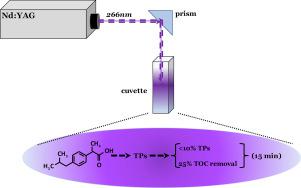Science of the Total Environment ( IF 8.2 ) Pub Date : 2020-06-29 , DOI: 10.1016/j.scitotenv.2020.140507 Francisco Rey-García 1 , Benigno José Sieira 2 , Carmen Bao-Varela 3 , José Ramón Leis 3 , Luis Alberto Angurel 4 , José Benito Quintana 2 , Rosario Rodil 2 , Germán Francisco de la Fuente 4

|
A novel approach based on the direct pulsed irradiation of UV-C light onto ibuprofen (IBP) solutions was evaluated in this work, as proof of concept for the direct removal of micropollutants. The experiments confirmed that laser irradiation is able to completely degrade IBP in 15 min in distilled water, with a DOC depletion of ca. 25% and with transformation products (TPs) remaining in solution and estimated to represent ca. 10% of the initial IBP concentration. In wastewater spiked samples, removal efficiency is slightly lower but still significant (ca. 5% IBP remaining after 15 min). Hence, this work suggests that low power solid state pulsed lasers, emitting at 266 nm wavelength, show promise for the removal of these type of micropollutants from water. These results open new opportunities towards the development of chemical-free water treatment methods based on direct, selective irradiation using state of the art, miniaturized laser devices.
中文翻译:

可以使用UV-C激光脉冲辐射从水中去除有机微量污染物吗?布洛芬案例研究。
在这项工作中评估了一种基于将UV-C光直接脉冲照射到布洛芬(IBP)溶液上的新颖方法,作为直接去除微量污染物的概念证明。实验证实,激光照射能够在蒸馏水中在15分钟内完全降解IBP,DOC损耗约为。25%,转化产物(TPs)保留在溶液中,估计约代表 初始IBP浓度的10%。在废水加标样品中,去除效率略低,但仍很显着(15分钟后剩余约5%IBP)。因此,这项工作表明,以266 nm波长发射的低功率固态脉冲激光器显示出从水中去除这类微污染物的希望。











































 京公网安备 11010802027423号
京公网安备 11010802027423号